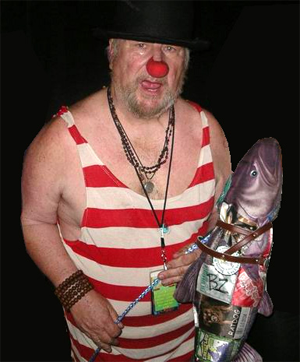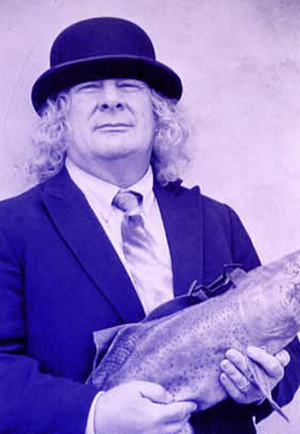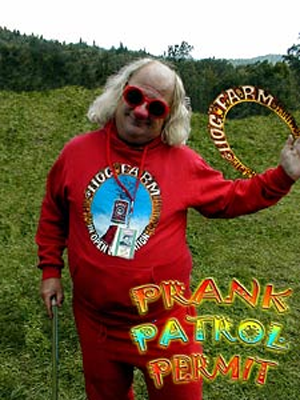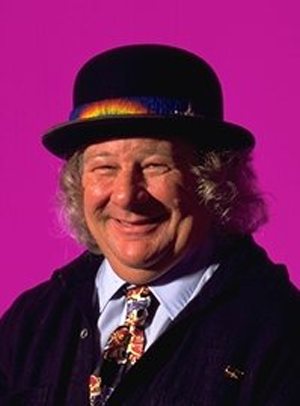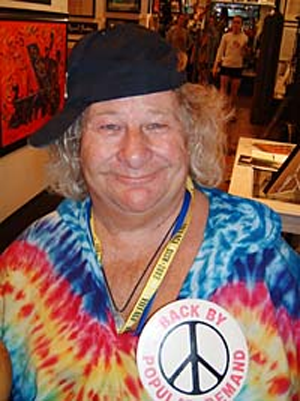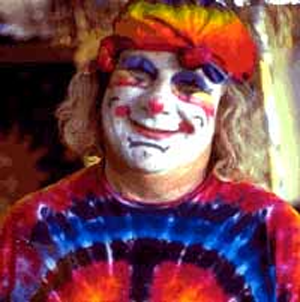by Martin A. Lee & Bruce Shlain
NOTICE: THIS WORK MAY BE PROTECTED BY COPYRIGHT
YOU ARE REQUIRED TO READ THE COPYRIGHT NOTICE AT THIS LINK BEFORE YOU READ THE FOLLOWING WORK, THAT IS AVAILABLE SOLELY FOR PRIVATE STUDY, SCHOLARSHIP OR RESEARCH PURSUANT TO 17 U.S.C. SECTION 107 AND 108. IN THE EVENT THAT THE LIBRARY DETERMINES THAT UNLAWFUL COPYING OF THIS WORK HAS OCCURRED, THE LIBRARY HAS THE RIGHT TO BLOCK THE I.P. ADDRESS AT WHICH THE UNLAWFUL COPYING APPEARED TO HAVE OCCURRED. THANK YOU FOR RESPECTING THE RIGHTS OF COPYRIGHT OWNERS.
Wavy Gravy holding "BZ" fish
It was from Hoffmann-La Roche in Nutley, New Jersey, that Edgewood Arsenal obtained its first sample of a drug called quinuclidinyl benzilate, or BZ for short. The army learned that BZ inhibits the production of a chemical substance that facilitates the transfer of messages along the nerve endings, thereby disrupting normal perceptual patterns. The effects generally last about three days, although symptoms -- headaches, giddiness, disorientation, auditory and visual hallucinations, and maniacal behavior -- have been known to persist for as long as six weeks. "During the period of acute effects," noted an army doctor, "the person is completely out of touch with his environment."
Dr. Van Sim, who served as chief of the Clinical Research Division at Edgewood, made it a practice to try all new chemicals himself before testing them on volunteers. Sim said he sampled LSD "on several occasions." Did he enjoy getting high, or were his acid trips simply a patriotic duty? "It's not a matter of compulsiveness or wanting to be the first to try a material," Sim stated. "With my experience I am often able to change the design of future experiments ... This allows more comprehensive tests to be conducted later, with maximum effective usefulness of inexperienced volunteers. I'm trying to defeat the compound, and if I can, we don't have to drag out the tests at the expense of a lot of time and money." With BZ Dr. Sim seems to have met his match. "It zonked me for three days. I kept falling down and the people at the lab assigned someone to follow me around with a mattress. I woke up from it after three days without a bruise." For his efforts Sim received the Decoration for Exceptional Civilian Service and was cited for exposing himself to dangerous drugs "at the risk of grave personal injury."
According to Dr. Solomon Snyder, a leading psychopharmacologist at Johns Hopkins University, which conducted drug research for the Chemical Corps, "The army's testing of LSD was just a sideshow compared to its use of BZ." Clinical studies with EA-2277 (the code number for BZ) were initiated at Edgewood Arsenal in 1959 and continued until 1975. During this period an estimated twenty-eight hundred soldiers were exposed to the superhallucinogen. A number of military personnel have since come forward claiming that they were never the same after their encounter with BZ. Robert Bowen, a former air force enlisted man, felt disoriented for several weeks after his exposure. Bowen said the drug produced a temporary feeling of insanity but that he reacted less severely than other test subjects. One paratrooper lost all muscle control for a time and later seemed totally divorced from reality. "The last time I saw him," said Bowen, "he was taking a shower in his uniform and smoking a cigar." [2]
After extensive clinical testing at Edgewood Arsenal, the army concluded that BZ was better suited than LSD as a chemical warfare agent for a number of reasons. While acid could knock a person "off his rocker," to use Chemical Corps jargon, BZ would also put him "on the floor" (render him physically immobile). This unique combination -- both "off the rocker" and "on the floor" -- was exactly what the army sought from an incapacitant. Moreover, BZ was cheaper to produce, more reliable, and packed a stronger punch than LSD. Most important, BZ could be dispersed as an aerosol mist that would float with the wind across city or battlefield. Some advantage was also found in the fact that test subjects lapsed into a state of "semi-quiet delirium" and had no memory of their BZ experience.
This was not to belittle lysergic acid. Although LSD never found a place in the army's arsenal, the drug undoubtedly left its mark on the military mind. Once again LSD seems to have acted primarily as a catalyst. Before acid touched the fancy of army strategists, Creasy's vision of a new kind of warfare was merely a pipe dream. With LSD it suddenly became a real possibility.
As the CIA and the military began to phase out their in-house acid tests in favor of more powerful chemicals such as BZ, which became the army's standard incapacitating agent. By this time the superhallucinogen was ready for deployment in a grenade, a 750-pound cluster bomb, and at least one other large-scale bomb. In addition the army tested a number of other advanced BZ munitions, including mortar, artillery, and missile warheads. The superhallucinogen was reportedly employed by American troops as a counterinsurgency weapon in Vietnam, and according to CIA documents there may be contingency plans to use the drug in the event of a major civilian insurrection. As Creasy warned shortly after he retired from the Army Chemical Corps, "We will use these things as we very well see fit, when we think it is in the best interest of the US and their allies."
_______________
Notes:
2. Pentagon spokespeople insist that the potential hazards of such experimentation were "supposed" to be fully explained to all volunteers. But as Dr. Snyder noted, nobody "can tell you for sure BZ won't have a long-lasting effect. With an initial effect of eighty hours compared to eight for LSD you would have to worry more about its long-lasting or recurrent effects."

